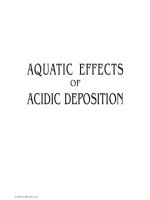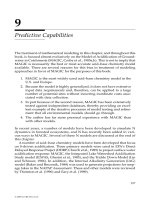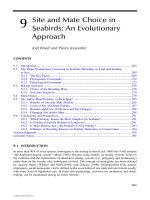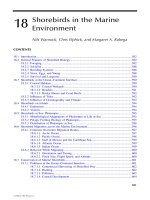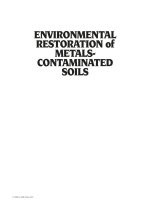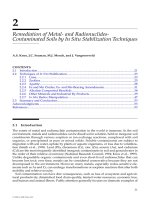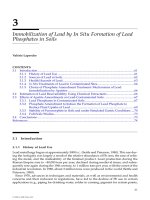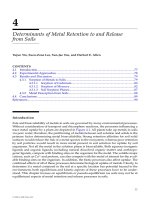ENVIRONMENTAL RESTORATION of METALSCONTAMINATED SOILS - CHAPTER 9 pptx
Bạn đang xem bản rút gọn của tài liệu. Xem và tải ngay bản đầy đủ của tài liệu tại đây (223.31 KB, 11 trang )
Section II
Biological Methods and Processes
4131/frame/C09 Page 187 Friday, July 21, 2000 4:52 PM
© 2001 by CRC Press LLC
189
9
The Relationships between the Phytoavailability and
the Extractability of Heavy Metals in Contaminated
Soils
Lenom J. Cajuste and Reggie J. Laird
CONTENTS
9.1 Introduction 189
9.2 Background 190
9.2.1 Sources of Soil Contamination 190
9.2.2 Chelating Agents as Soil Tests for Heavy Metals 191
9.3 Materials and Methods 193
9.3.1 Field Observations 193
9.3.2 Sample Preparation and Analysis 193
9.4 Results and Discussion 194
9.4.1 Effect of Chelates on Metal Removal 194
9.4.2 Extractable Metals and Phytoavailability Relationships 194
9.5 Conclusions 197
9.6 Summary 197
References 197
9.1 Introduction
Since the beginning of this century, with the era of intensive Mexican industrialization
there has been considerable interest in applying the wastewater collected from the metro-
politan area of Mexico City to croplands of the Mezquital Valley. This municipal waste-
water has been recognized as a valuable source of plant nutrients such as N, P, and minor
elements that favor adequate crop growth (Cajuste et al., 1991; Juste and Mench, 1992). In
spite of these beneficial effects, there is concern about the potential hazard associated with
the consumption of the edible portion of crops grown in this area because of metal phyto-
toxicity or transfer of the metal into the food chain (Chang, 1984; Adriano, 1986; Rappaport
et al., 1988; Miller et al., 1995). Various chemical extractants such as the EDTA method
(Haq et al., 1980), the DTPA soil test of Lindsay and Norvell (1978), and the AB-DTPA
procedure (Soltanpour, 1985) have been proposed to evaluate the phytoavailability of
heavy metals from contaminated soils.
4131/frame/C09 Page 189 Friday, July 21, 2000 4:52 PM
© 2001 by CRC Press LLC
190
Environmental Restoration of Metals–Contaminated Soils
9.2 Background
9.2.1 Sources of Soil Contamination
The contamination of soil can derive from distinct activities such as (1) industrial opera-
tions, (2) agricultural activities, and (3) agricultural domestic and urban activities. Some
environmental contaminants and their associated sources are presented in Table 9.1.
As a consequence of the adverse effects of the technical civilization of the world, soil as a
component of the biosphere has been viewed as a natural buffer system that controls the
fate of chemical elements in the environment.
Heavy metals are common sources of soil contaminants; they are also present in natural
waters because of natural processes or man’s activities. In this aqueous phase they do not
stay under the soluble form for a long time; they are rather present as suspended colloids
or they are fixed by organic material and mineral substances (Kabata-Pendias and Pendias
1992). The anthropogenic sources of trace elements in waters are associated with mining
of coal and mineral ores, and manufacturing and municipal wastewater operations
(Förstner, 1995).
Most of the regional contamination of the soil originates from industrial regions and
urban areas where factories, motor vehicles, and municipal waste are the common sources
of heavy metals. Furthermore, fertilizers, pesticides, and sewage sludge constitute other
important sources of heavy metals in the soil (Table 9.2). Effects of sewage sludge applica-
tion on soil composition are of great environmental concern because of their heavy cumu-
lative load, which tends to increase the soils’ levels of Ni, Cr, Pb, Zn, Cu, and Hg because
of long-term use (Chaney, 1978; Henry and Harrison, 1992).
TABLE 9.1
Some Heavy Metals Regarded as Environmental Pollutants
Element Sources
Concentration Range
(mg kg
–1
)
Cd Burning of coal ash 1–200
Water pipes —
Smelting 6,000–80,000
Ni Oil (residual/diesel)
Coal ash
Gasoline additives
—
3–1,300
—
Pb Coal ash
Motor vehicle, leaded gasoline
Battery reclamation
Battery recycling
10–7,000
—
2.16–43,700 (sediment)
2–135,000 (soil)
0–140 mg L
–1
(waters)
210–75,850 (soil)
Cr Wood preserving, tanneries, mining
Chromium production
—
500–70,000
Adapted from Peters, R.W. and L. Shem, Treatment of soils contaminated with
heavy metals, in
Metal Speciation and Contamination of Soils
, H.A. Allen, C.P. Huang,
G.W. Bailey, and A.R. Bowers, Eds., Lewis Publishers, Boca Raton, FL, 1995.
4131/frame/C09 Page 190 Friday, July 21, 2000 4:52 PM
© 2001 by CRC Press LLC
The Relationships between the Phytoavailability and the Extractability of Heavy Metals
191
In addition to sewage sources of trace pollutants, heavy metals also can derive from other
soil contaminant sources. For example, lead originates from motor vehicle exhaust, espe-
cially in the vicinity of highways, or from smelters and mining operations. Copper and
chromium as soil contaminants are found in discharges from tanneries and wood preserv-
ing plants. Another common soil contaminant is arsenic which has found wide use in the
past as a preservative of hides in tanning (Connell, 1997). All of these elements, including
Se, B, Mo, are of primary concern to plant, animal, and human health. Of these, in terms of
uptake and accumulation by food chain crops, cadmium poses the greatest long-term
threat to human health. A report from CAST (Council for Agricultural Science and Technol-
ogy, 1976) summarizes the impact of these metals on plant and animal health; for example,
Cd, Cu, Ni, Zn, and Mo are the elements that plants can accumulate and then become prob-
lems throughout the food chain. Copper, nickel, and zinc can cause phytotoxicity at ele-
vated levels in acid soils. Boron, molybdenum, and arsenic are of concern for both plant
and animal health, and Se is of concern for animal health. Because they form sparingly sol-
uble compounds in the soil, mercury and lead are not taken by plants in amounts harmful
to consumers and have not posed a direct food chain problem for land application of sew-
age sludge. However, through other pathways of the food chain, such as direct ingestion
from soil or the edible portion of crops, they can be harmful to the consumers.
A wide range of organic substances also occurs as contaminants in soils; of particular
interest are petroleum products, paints, oils, waxes, solvents, plasticizers, pigments, and so
forth. These organic substances can be divided into several groups including pesticides,
polychlorinated biphenyls (PCBs), polycyclic aromatic hydrocarbons (PAHs), halogenated
aliphatics, ethers, phtalate esters, phenols, monocyclic aromatics, and nitrosamines (Som-
mers and Barbarick, 1988; Jorgensen and Johnsen, 1989).
All of these substances would be expected to be present in urban areas and agricultural
land. The concentrations of most tend to decrease with time because of environmental
transformation and degradation processes; however, some, will tend to persist in the envi-
ronment for many years, or even many decades.
9.2.2 Chelating Agents as Soil Tests for Heavy Metals
Many heavy metals (essential and nonessential) are taken up by plants at a level often
without any cause for concern; however, when crops are cultivated in contaminated soils,
TABLE 9.2
Sources of Some Trace Elements in Agricultural Soils
Element
Sewage Sludge Phosphate Fertilizers Nitrogen Fertilizers
Pesticides
(%)
mg kg
–1
dry weight
As 2–26 2–1200 2.2–120 22–60
B15–1000 5–115 ——
Cd 2–2500 0.1–170 0.05–8.5 —
Cr 20–40,600 66–245 3.2–19.0 —
Cu 50–3300 1–300 <1–15 12–50
Hg 0.1–55 0.02–1.2 0.3–2.9 0.8–42
Mo 1–40 0.1–60 1–7 —
Ni 16–5300 7–38 7–34 —
Pb 50–3000 7–2225 2–27 60
Se 2–9 0.5–25 ——
Zn 700–49,000 50–1450 1–42 1.3–25
Adapted from Kabata-Pendias, A. and H. Pendias,
Trace Elements in Soil and Plants
, CRC
Press, Boca Raton, FL, 1992.
4131/frame/C09 Page 191 Friday, July 21, 2000 4:52 PM
© 2001 by CRC Press LLC
192
Environmental Restoration of Metals–Contaminated Soils
metal plant concentrations may reach phytotoxic levels. There is, therefore, a need to
monitor heavy metal content of soils. Considerable research has been done on the extrac-
tion of heavy metals from contaminated soils by chelating agents, primarily the EDTA
(ethylenediamine-tetraacetic acid) and the DTPA (diethylenetriaminepentaacetic acid).
These chelates decrease the activity of metal ions in soil solution by giving rise to the
formation of soluble metal chelate complexes.
Initial efforts in selecting a chelate for studying the fate of metals in the environment
have centered around EDTA. In an experiment carried out on treatment of a soil contam-
inated with Cd, Cr, Cu, Pb, and Ni, Ellis et al. (1986) reported that the EDTA chelated and
solubilized all of the metals to some degree. On the other hand, EDTA was seen to offer
good potential as soil washing additive for the removal of Pb from soils (Peters and
Shem, 1995).
Elliot et al. (1989) in a series of batch experiments evaluated extractive decontamination
of Pb-polluted soil using EDTA. Their results showed that increasing EDTA concentration
resulted in a greater Pb release and that recovery of Pb was higher under acidic than alka-
line conditions.
Many studies have indicated that soil-test-extractable heavy metals can be correlated
with their associated levels in plants. Bowman et al. (1981) found that Ni was complexed
and therefore was maintained in soluble form from different agricultural soils and poten-
tial waste disposal sites, in the presence of a high level of Ca ions and a small amount of
chelating agent EDTA.
The Lindsay and Norvell (1978) procedure using DTPA is one of the most popular soil
chelating extractants. Haq et al. (1980) in a greenhouse study compared nine extractants for
plant available Zn, Cd, Ni, and Cu in 46 Canadian soils contaminated with heavy metals;
they concluded that DTPA-extractable metals were best correlated with heavy metals
uptake by plant.
Because the DTPA soil test is to some extent tedious and laborious to perform in
laboratories, Soltanpour and Schwab (1977) proposed a simplification of the method by
combining the DTPA test with ammonium bicarbonate and by making some adjustments
relative to the solution pH and the extracting time. Barbarick and Workman (1987), by
comparing DTPA and AB-DTPA-extractable Cd, Cu, Ni, Pb, and Zn with metal plant
concentration from a greenhouse experiment, found a highly significant linear relation-
ship between these parameters. They also indicated that either extractant could predict
some accumulation of these metals in the field, and that the relationships between
AB-DTPA-extractable metal and their associated levels in plant were markedly influ-
enced by soil pH. Rappaport et al. (1988) evaluated the ability of DTPA to predict heavy
metal (Cd, Cu, Ni, and Zn) availability to corn grown in three soils amended with high
doses of sewage sludge. Corn, grain, and stover yields, and DTPA-extractable Cd, Cu, and
Ni were closely related to sludge rate, although the critical phytotoxic level of these metals
could not be established.
Intensive efforts have been directed (Wang 1997) at the development of sequential frac-
tionation schemes that quantitatively partition the total amount of a heavy metal into soil
pools that may be interpreted for predicting metal phytoavailability from contaminated
soils. In this regard, greenhouse and field studies have been conducted to relate these
chemical fractions to plant uptake and soil test extractable levels.
The objectives of this study were (1) to compare the EDTA extractant to DTPA and
AB-DTPA for the removal of metals from contaminated soils; and (2) to determine the
relationships between EDTA, DTPA, and AB-DTPA extractable metals of the wastewater
irrigated soils and the metal concentrations in alfalfa (
Medicago sativa L.
) grown in the
same fields.
4131/frame/C09 Page 192 Friday, July 21, 2000 4:52 PM
© 2001 by CRC Press LLC
The Relationships between the Phytoavailability and the Extractability of Heavy Metals
193
9.3 Materials and Methods
9.3.1 Field Observations
Composite soil samples (Typic Calciorthids, 0 to 15 cm depth) were collected from 17 alfalfa
plots located in the irrigation District 03 in the Mexican Valley of Mezquital. These plots
were irrigated with wastewater from domestic and industrial effluents of the metropolitan
area of Mexico City (Cajuste 1991), over different periods of time (Table 9.3).
9.3.2 Sample Preparation and Analysis
Soil samples were dried and ground for laboratory analyses. Soil characterization included
the determination of pH, percent clay, percent organic matter, and total Cd, Ni, and Pb.
Plant samples collected from the 17 plots were dried at 70°C for 48 h and ground in a Wiley
mill to pass through a 1-mm sieve. They were then digested with a HClO
4–
·H
2
SO
4
acid mix-
ture (1:4) and analyzed for Cd, Ni, and Pb using an AA spectrophotometer (Table 9.4).
A batch experiment was conducted to determine extractable Cd, Ni, and Pb from the soils
by using the following conventional methods for plant micronutrients: 0.05
M
EDTA,
pH 7.0; 0.005
M
DTPA, pH 7.3; 0.005
M
AB-DTPA, pH 7.6; and the same solutions at pH 6.0
and 8.4. Additionally, duplicates of 1-g samples of soil were analyzed using the following
TABLE 9.3
Sampling Sites as Related to Date of Wastewater Application
Sites Location Series
First Year under
Irrigation
No. of Years
Irrigated
2-1, S-2, S-3 Tlaxcoapan Lagunilla 1912 87
2-4, S-5 Tlahualilpan Tepatepec 1912 87
2-6, S-7, S-8 Mixquiahuala Progreso 1920 79
S-9, S-10 Tepatepec Tepatepec 1954 35
S-11 Actopan Lagunilla 1972 27
S-12, S-13 Atitalaquia Lagunilla 1976 23
S-14, S-15 Clavijero Tepatepec 1976 23
S-16, S-17 Xicudo Progreso 1979 20
TABLE 9.4
Range, Mean, and Standard Deviation of Soil Characteristics and Metal
Concentrations in Alfalfa Tissue
Parameter Range (n = 17) Mean Standard Deviation
pH 6.9–8.1 7.5 0.34
OM (g kg
–1
)14–53 34 0.85
Clay (g kg
–1
) 240–700 412.4 13.7
Soil Cd (
µ
g g
–1
) 17.4–39.1 30.8 1.17
Soil Ni (
µ
g g
–1
) 11.5–35.1 21.6 6.05
Soil Pb (
µ
g g
–1
) 7.7–63.0 41.7 1.52
Plant Cd (
µ
g g
–1
) 0.48–1.97 1.28 0.47
Plant Ni (
µ
g g
–1
) 3.18–9.09 6.35 1.49
Plant Pb (
µ
g g
–1
) 1.26–7.70 3.30 1.68
4131/frame/C09 Page 193 Friday, July 21, 2000 4:52 PM
© 2001 by CRC Press LLC
194
Environmental Restoration of Metals–Contaminated Soils
extractants: 0.01
M
and 0.1
M
EDTA, DTPA, and AB-DTPA at pH 7.0, 7.3, and 7.6, respec-
tively. Cd, Ni, and Pb were determined by the same procedure mentioned above.
Statistical analyses (correlation and regression procedures) were carried out to compare
soil tests and to relate the amounts of Cd, Ni, and Pb extracted from the soils to their
associated concentrations in alfalfa tissue.
9.4 Results and Discussion
9.4.1 Effect of Chelates on Metal Removal
Amounts of metal extracted from the soils, on the average, varied widely, according to solu-
tion pH and chelate concentrations. The conventional EDTA method was, in general, more
effective in removing metals than the DTPA and AB-DTPA soil tests, presumably because
of its stronger solution concentration than the other solutions, thus favoring greater metal
solubility (Table 9.5). An increase in chelate concentration generally resulted in greater
metal release by EDTA and DTPA, but this effect was not consistent in the extraction of met-
als by AB-DTPA (Table 9.6). Increased solubility of metal ions as influenced by chelate com-
plexation has been reported by many researchers (Ellis et al., 1986; Peters and Shem, 1995;
Elliott et al., 1989; Bowman et al., 1981); they suggest that complexing agents offer the
potential to be effective extractants of heavy metals from contaminated soils because of the
increase in metal solubility.
There was no consistent effect of solution pH on the extraction of metals; for instance, an
increase in soil test pH showed a negative effect on the level of EDTA extractable Cd and the
amounts of Pb removed by chelates (Table 9.5). The quantity of Ni extracted by the chelates,
however, showed an opposite trend and DTPA-extractable Cd was insensitive to pH variation.
9.4.2 Extractable Metals and Phytoavailability Relationships
Correlation coefficients between soil tests were highly significant (
P
= 0.01) (data not
presented). Correlations between the amounts of metals extracted by the conventional
TABLE 9.5
Removal of Heavy Metals from the Soils (Average Values) by Chelates at Different Solution pH
Values
pH Cd Ni Pb
(
µ
g g
–1
)
EDTA (0.05
M
) 6.0 2.56 2.11 2.90
7.0
a
2.17 7.57 2.44
8.4 1.99 8.26 2.49
DTPA (0.005
M
) 6.0 1.02 1.24 2.80
7.3
a
1.14 1.86 0.66
8.4 1.00 2.32 0.62
AB-DTPA (0.005
M
) 6.0 1.07 1.26 2.18
7.6
a
2.26 4.74 1.89
8.4 1.22 3.34 1.27
a
pH of the solution of the conventional method.
4131/frame/C09 Page 194 Friday, July 21, 2000 4:52 PM
© 2001 by CRC Press LLC
The Relationships between the Phytoavailability and the Extractability of Heavy Metals
195
methods (0.05
M
EDTA, pH 7.0; 0.005
M
DTPA, pH 7.3; 0.005
M
AB-DTPA, pH 7.6) as well
as at 0.01
M
and 0.1
M
concentrations of the chelates, and their associated total levels in soils
and plant tissue were carried out. As only the top portion of the alfalfa plant was sampled
and inasmuch as dry matter was not correlated with metal concentration in alfalfa tissue,
metal concentration in the plant was used instead of total metal uptake. In general, total Cd
and Pb correlated very significantly with soil tests (Table 9.7). Although soil organic matter
had a positive and significant effect on total Cd, percent clay was not similarly correlated
(Table 9.7). This seems to indicate that Cd bound to organic matter was more important as a
source of soil Cd than the Cd retained on the mineral exchange complex.
A significant correlation was found between plant Cd concentration and Cd removed by
the three EDTA concentrations and the conventional DTPA procedure. Phytoavailable Cd,
however, correlated poorly with AB-DTPA-Cd and the other soil properties (Table 9.7).
Likewise, total Pb and Pb concentration in the plant were not correlated with soil pH,
organic matter, or percent clay (Table 9.7).
Relationships between total levels of Ni in soil and plant and their amounts complexed
by the chelates showed, to some extent, a different pattern. Total Ni was directly related to
TABLE 9.6
Averaged Amounts of Cd, Ni, and Pb Removed from the Soils as Influenced by Solution of Chelates
Chelates
pH Solution Cd Ni PB
(
µ
g g
–1
)
EDTA 7.0 0.01 1.4 1.8 1.0
0.05
a
2.6 7.6 2.1
0.1 2.2 10.4 2.4
DTPA 7.3 0.005
a
1.1 1.9 0.7
0.01 6.8 2.3 1.5
0.1 12.3 7.7 7.7
AB-DTPA 7.6 0.005
a
2.3 4.7 1.9
0.01 10.4 3.2 1.3
0.1 9.7 2.8 1.5
a
Solution concentration of the conventional method.
TABLE 9.7
Correlation Coefficients (r) between Metals Extracted by the Chelates and Total Metal Content in
Soil and Metal Concentration in Alfalfa Tissue
ED1 ED2 ED3 DT1 DT2 DT3 AB1 AB2 AB3 pH OM Cl
Cd
Cdtot 0.78*** 0.77*** 0.80*** 0.80*** 0.83*** 0.50* 0.75*** 0.67*** 0.68*** –0.5* 0.52* –0.10
CdPp 0.48* 0.55** 0.50* 0.52* 0.45 0.37 0.46 0.36 0.37 –0.19 0.22 0.37
Ni
Nitot 0.54** 0.52* 0.67** 0.81*** 0.78*** 0.58** 0.80*** 0.81*** 0.74*** 0.63** 0.20 –0.01
NiPp 0.72*** 0.62** 0.64** 0.46 0.18 0.51* 0.35 0.30 0.39 0.62** 0.04 0.09
Pb
Pbtot 0.78*** 0.84*** 0.89*** 0.47* 0.88*** 0.69*** 0.71*** 0.92*** 0.86*** –0.43 0.30 0.06
PbPP 0.68** 0.72** 0.67** 0.54** 0.47* 0.61** 0.34 0.56** 0.58** –0.28 0.27 –0.03
Note:
ED1 to ED2, DT1 to DT3, and AB1 to AB3 mean 0.01, 0.05, and 0.1
M
EDTA, 0.005, 0.01 and 0.1
M
DTPA,
and 0.005, and 0.01, and 0.1
M
AB-DTPA, respectively.
Cdtot, Nitot, and Pbtot = Total Cd, total Ni, and total Pb in soils, respectively.
CdPp, NiPp, and PbPp = Cd, Ni, and Pb concentration in plant, respectively.
4131/frame/C09 Page 195 Friday, July 21, 2000 4:52 PM
© 2001 by CRC Press LLC
196
Environmental Restoration of Metals–Contaminated Soils
Ni extracted by soil tests and plant Ni concentration was found to be strongly influenced
by soil pH, and only by EDTA-Ni and 0.1
M
DTPA-Ni (Table 9.7).
In the case of soil Ni, similar observations were made by Wang et al. (1997) who found that
DTPA-extractable Ni correlated significantly with soil Ni fractions as a result of a sequential
fractionation analysis from a pot experiment. They suggested that the DTPA-extractable Ni
in terms of phytoavailability was related to the concentrations in soil fractions.
The amounts of metals removed from the soils by the conventional chelating methods
over the whole period of irrigation management correlated poorly with plant metal con-
centrations; extractable metals, in general, accounted for less than 50% of the variability of
plant metal concentrations. This indicates that data for metals extracted during the first
period of irrigation management may not belong to the same population as the data from
the sites irrigated during the last 20 years. The separation of the data on the accumulation
of metals for sampling sites with relatively short- and long-term periods of irrigation man-
agement, corresponding to time intervals of 20 to 23 and 45 to 87 years, respectively,
improved the prediction of metal phytoavailability dependence, solely on extractable met-
als or on these in combination with other soil variables.
Regression equations between plant-available metals and their associated extractable
metals for Group I (20 to 23 years of irrigation management) and Group II (45 to 87 years
of irrigation management) are shown below. (Data for one site in each group were deleted
for each of the three metals, as metal concentrations in alfalfa plants grown in the two sites
were much higher than the other values and would have biased the regression equations.)
GROUP I
Pb P
p
= 0.912 + 1.114 EDTA-Pb R
2
= 0.854** (1)
Pb P
p
= 2.918 + 1.910 EDTA-Pb + 1.191 OM R
2
= 0.667* (2)
Cd P
p
= 4.191 + 0.048 EDTA-Cd – 0.117 pH R
2
= 0.669* (3)
Ni P
p
= –3.960 + 0.295 EDTA-Ni – 1.636 pH R
2
= 0.873** (4)
GROUP II
Pb P
p
= 0.078 + 0.998 EDTA-Pb + 3.357 OM R
2
= 0.853** (5)
Cd P
p
= –2.017 + 0.380 EDTA-Cd – 0.332 pH R
2
= 0.514* (6)
Ni P
p
= 9.351 + 0.391 EDTA-Ni + 0.109 OM R
2
= 0.796** (7)
Cd P
p
= 8.298 – 0.615 pH + 0.665 OM R
2
= 0.718** (8)
In these equations, Pb P
p
, Cd P
p
, and Ni P
p
mean Pb, Cd, and Ni concentration in the plant,
respectively.
In Group I, the highest regression coefficient was observed when the plant concentration
of Ni was regressed on the amount of Ni extracted with 0.05
M
EDTA, pH 7.0, and soil pH.
This regression accounted for about 87% of the variability of plant Ni concentrations. In the
case of Group II, the combined effect of EDTA-extracted Pb and percent organic matter was
responsible for 85% of the variability in plant Pb concentrations. On the other hand, the
removal of Pb by EDTA alone could explain 85% of the variation in plant Pb concentrations
(Equation 1).
A somewhat different situation was observed with Cd in Group II, where about 72% of
the variability in plant concentration of Cd could be explained by differences in soil pH and
percent organic matter (Equation 8). EDTA extractable Cd, on the other hand, had only a
moderate influence on phytoavailable Cd as reflected in a value of R
2
= 0.514 (Equation 6).
4131/frame/C09 Page 196 Friday, July 21, 2000 4:52 PM
© 2001 by CRC Press LLC
The Relationships between the Phytoavailability and the Extractability of Heavy Metals
197
These results are in agreement with earlier findings of some researchers (Haq et al., 1980;
Ellis et al., 1986; Peters and Shem, 1995; Elliot, 1989; Bowman et al., 1981; Soltanpur and
Schwab, 1977; Barbarick and Workman, 1987; Peters and Ku, 1987; Wang et al., 1997; Xiu
et al., 1991; Jorgensen and Johnsen, 1989) who showed that these three extractants have
proved to be reliable chemical methods for assessing the levels of toxic metals in soils.
9.5 Conclusions
The three chelating agents appeared to be effective extractants in removing metals from
contaminated soils. The EDTA procedure was the best single extracting agent for most
metals. Extractable metals were, to some extent, influenced by solution pH and chelate
concentrations. Correlation coefficients between soil tests were highly significant, but
extractable metals accounted for less than 50% of the variability of plant metal concentra-
tions. The separation of the soils into two groups, based on the number of years of irrigation
management, improved the prediction of metal phytoavailability, solely in terms of the
amounts of extractable metals or on these in combination with other soil variables.
9.6 Summary
Chelating agents are known to be effective extractants of heavy metals from contaminated
soils. This study was aimed to compare the DTPA procedure with the EDTA and AB-DTPA
soil tests for extraction of Cd, Ni, and Pb, and to determine the relationships between soil
extractable metals and associated alfalfa (
Medicago sativa
L.) plant concentrations.
Soil samples (Typic Calciorthids) were collected from 17 unfertilized plots irrigated with
wastewater. They were analyzed for metal contents using varying chelate concentrations
and at three pH values. Plant samples were obtained from the sites and were analyzed for
metal content. Results indicated that EDTA, in general, extracted greater amounts of metals
than DTPA, regardless of solution pH. The amounts of metals removed were influenced by
extractant concentrations. Correlation coefficients between soil tests were highly significant
(
P
= 0.01), but regression analysis between plant and soil extractant concentration
accounted for less than 50% of the variation; however, the separation of the soil sites by
amounts of time under irrigation with wastewater improved the relationship between
these two parameters.
References
Adriano, D.C., Nickel, in
Trace Elements in the Terrestrial Environment
, Springer-Verlag, New York,
1986, 362.
Barbarick, K.A. and S.M. Workman, Ammonium bicarbonate-DTPA and DTPA extractions of sludge-
amended soils,
J. Environ. Quality
, 16, 125, 1987.
Bowman, R.S., M.S. Essington, and G.A. O’Connor, Soil sorption of nickel: influence and composition,
Soil Sci. Soc. Am. J.,
45, 860, 1981.
4131/frame/C09 Page 197 Friday, July 21, 2000 4:52 PM
© 2001 by CRC Press LLC
198
Environmental Restoration of Metals–Contaminated Soils
Cajuste, L.J., R. Carrillo-G, E. Cota-G, and R.J. Laird, The distribution of metals from wastewater in
the Mexican Valley of Mezquital,
Water, Air, Soil Pollut.
, 57, 673, 1991.
Chaney, R.L., Plant acummulation of heavy metals and phytotoxicity resulting from utilization of
sewage sludge and sludge compost on cropland, in
Proc. 1977 Conf. Nat. Composting of Municipal
Residues and Sludges
, Rockville, MD, 1978, 86.
Chang, A.C., J.E. Warneke, A.L. Page, and L.J. Lund, Accumulation of heavy metals in sewage
sludge-treated soils,
J. Environ. Quality
, 13, 287, 1984.
Connell, D.W.,
Environmental Chemistry
, Lewis Publishers, Boca Raton, FL, 1997, 289.
Council for Agricultural Science and Technology, Application of Sewage Sludge to Cropland: Appraisal
of Potential Hazards of the Heavy Metals to Plants and Animals, CAST, Ames, IA, 1976, 64.
Elliott, H.A., G.A. Brown, G.A. Schields, and J.H. Lynn, Restoration of Pb polluted soils by EDTA
extraction, in
7th Int. Conf. Heavy Metals in the Environment
, Vol. 2, J P. Vernet, Ed., Geneva,
Switzerland, 1989, 64.
Ellis, W.D., T.R. Fogg, and A.N. Tafuri, Treatment of soil contaminated with heavy metals, in
Land
Disposal, Remedial Action, Incineration and Treatment of Hazardous Waste
, 12 Ann. Res. Symp. EPA
600/9–86/022, Cincinnatti, OH, 1986, 201.
Förstner, U., Land contamination by metals: global scope and magnitude of problem, in
Metal
Speciation and Contamination of Soil, H.E. Allen, C.P. Huang, J.W. Bailey, and A.R. Bowers, Eds.,
Lewis Publishers, Boca Raton, FL, 1995.
Haq, A.V., T.E. Bates, and Y.K. Soon, Comparison of extractants for plant-available Zn, Cd, Ni and
Cu in contaminated soils, Soil Sci. Soc. Am. J., 44, 772, 1980.
Henry, C.L. and R.B. Harrison, Fate of trace metals in sewage sludge compost, in Biogeochemistry of
Trace Metals, D.C. Adriano, Ed., Lewis Publishers, Boca Raton, FL, 1992.
Jorgensen, S.E. and I. Johnsen, Principles of Environmental Science and Technology, Elsevier, Amsterdam,
1989, 270.
Juste, C. and M. Mench, Long-term application of sewage sludge and its effect on metal uptake by
crops, in Biogeochemistry of Trace Metals, D.C. Adriano, Ed., Lewis Publishers, Boca Raton, FL,
1992.
Kabata-Pendias, A. and H. Pendias, Trace Elements in Soil and Plants, CRC Press, Boca Raton, FL, 1984.
Lindsay, W.L. and W.A. Norvell, Development of DTPA test for zinc, iron, manganese and copper,
Soil Sci. Soc. Am. J., 42, 421, 1978.
Miller, R.W., A.S. Azzari, and D.T. Gardiner, Heavy metals in crops as affected by soil types and
sewage sludge rates, Commun. Soil Sci. Plant Anal., 26, 703, 1995.
Peters, R.W. and L. Shem, Treatment of soils contaminated with heavy metals, in Metal Speciation
and Contamination of Soils, H.A. Allen, C.P. Huang, G.W. Bailey, and A.R. Bowers, Eds., Lewis
Publishers, Boca Raton, FL, 1995.
Peters, R.W. and Y. Ku, The effect of citrate, a weak complexing agent, on the removal of heavy
metals by sulfide precipitation, in Metals Speciation, Separation and Recovery, J.W. Patterson and
R. Passino, Eds., Lewis Publishers, Boca Raton, FL, 1987.
Rappaport, B.D., D.C. Martens, R.B. Renaud, Jr., and T.W. Simpson, Metal availability in sludge-
amended soils with elevated metal levels, J. Environ. Quality, 17, 42, 1988.
Soltanpour, P.N., Use of ammonium bicarbonate DTPA to evaluate elemental availability and toxicity,
Commun. Soil Sci. Plant Anal., 16, 323, 1985.
Soltanpour, P.N. and A.P. Schwab, A new soil test for simultaneous extraction of macro and micro-
nutrients in soils, Commun. Soil Sci. Plant Anal., 3, 195, 1977.
Sommers, L.E. and K.A. Barbarick, Constraint to land application of sewage sludge, in Utilization,
Treatment and Disposal of Waste on Land, SSSA, Madison, WI, 1988.
Wang, P., E.Qu, Z. Li, and L.M. Shuman, Fraction availability of nickel in loessial soil amended with
sewage or sewage sludge, J. Environ. Quality, 26, 795, 1997.
Xiu, H., R.W. Taylor, J.W. Shuford, and W. Tadesse, Comparison of extractants for available sludge-
born metals: a residual study, Water, Air, Soil Pollut., 57, 913, 1991.
4131/frame/C09 Page 198 Friday, July 21, 2000 4:52 PM
© 2001 by CRC Press LLC

